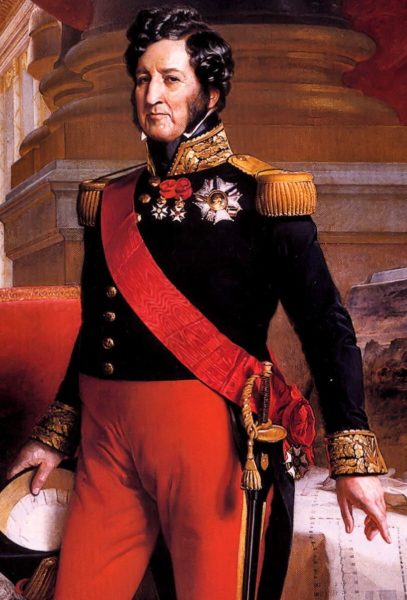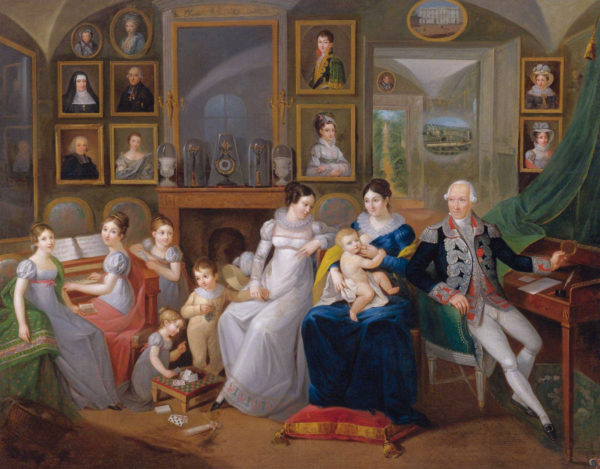
One of the things that France keeps a very low profile about is the fact that French aristocracy did not disappear with the French Revolution. Yes, it was thinned out by Madame Guillotine but enough of them survived so that more than 220 years later, the nobility population (la noblesse) is about the same as before the Revolution.
Contemporary Aristocracy
You don’t hear much about the contemporary nobility today. Many of the families can trace their origins to the Middle Ages. The de Vogues family dates back to the 12th-century and their forefathers were likely members of the king’s court. However, like most of la noblesse, the de Vogues family tries to not attract attention to their historical or hereditary status. Why?

France is a republic. In fact it’s on its Fifth Republic. The First Republic, 1792 to 1804, was interrupted by Napoléon I and his empire. After they finally got rid of that pesky little guy once and for all, the monarchy returned to France with Kings Louis VIII, Charles X, and Louis-Philippe I. By 1848, the people had had enough of its kings and their monarchies and the Second Republic came into existence. Four years later, its first elected president, Louis-Napoléon Bonaparte (the little guy’s nephew), decided to become Emperor Napoléon III (after he had declared himself “president for life.”) He dissolved the republic and between 1852 and 1870, a new empire ruled France. After engineering France’s defeat to the Prussian army, Napoléon III fled the country. The Third Republic was formed and shortly thereafter, crushed the 1871 Commune uprising. Generally considered to be corrupt and ineffective, it was dissolved in 1940 when the Vichy government partnered with Hitler and collaborated with the Nazis throughout the occupation. Upon liberation and the end of the war, the Fourth Republic was formed. It lasted until 1958 when the present Fifth Republic came into existence.
What’s It Like to Be a Republican?–In France

What does it mean to be a republic like France? It is a mindset and culture. The French believe very strongly in their motto that had its origins during the Revolution: Liberté, égalité, fraternité or Liberty, equality, fraternity. Despite being overwhelmingly Catholic, the country is very secular. The separation of church and state is one of the government’s guiding principles. The idea of a separate legal class of citizens built on heredity is probably offensive to most of the French.
So how does one identify a contemporary noble? Is it their surname with a “de” as in the Duc de Penthièvre? Some yes, some no. Charles de Gaulle was certainly not part of the French aristocracy. What about families that live in the châteaux? Are they nobility? Again, some yes, some no. Like the English nobility (yes, they still do exist), many of them struggle to maintain their ancestral family homes.
Pretenders to the French Throne

Are there still monarchists lurking around? There sure are. The three primary claimant groups are the “Legitimists” representing the House of Bourbon (the last legitimate royal blood line ending with Charles X), the “Orléanists” representing the House of Orléans (Louis-Philippe’s son was the last Duke of Orléans and fathered the future Count of Paris), and the “Bonapartists” (enough said on this one). Current pretenders to the throne include Louis Alphonse, Duke of Anjou (Legitimists), Prince Henri, Count of Paris (Orléanists), and Jean Christophe, Prince Napoléon (Bonapartists). During the 19th-century, political opponents to the sitting king or emperor needed to emigrate or else be thrown into prison. Fortunately, that’s not the case today.

If you are a French noble (and can prove it), you fall into one of four categories: an ancien régime duke, a Restoration duke, a Napoléonic duke, or a Papal duke. The CEO of the Michelin Company, Jean-Dominique Senard, can trace his roots back to nobility. He is considered a papal duke. I know your next question and I don’t have the answer as to how one is classified.
Stew Ross, Duke and Sun King of Punta Gorda
Hopefully I can find out which bistro the nobility hang out at in Paris. It would be interesting to listen to their stories and maybe find someone to confer noble status on me (sort of like being made a Kentucky colonel). I’m not Catholic so I can’t be a papal duke. I don’t want to be a Restoration or Napoléonic duke. So that leaves becoming an ancien régime duke. That sounds good . . . Louis XIV was the “Sun King” and epitomized the ancien régime.
Black Ribbons Around Throats

By the way, if you’re out visiting châteaux and other historic residences of the nobility, you may see portrait paintings hanging on the walls. If the painting is pre-Revolution and the subject has a black ribbon painted around their neck, they were a victim of the guillotine during the Revolution. The black ribbon was painted in after the Revolution ended.
(Some of the information for this blog post came from the online BBC Magazine News article by Hugh Schofield-Why France’s aristocracy hasn’t gone away).
Sandy and I hope you enjoy our new look for the web and blog site. She has worked diligently with the team from Metacake to upgrade our site. We always welcome your comments and suggestions for improvement—looking forward to hearing from you.
Someone Is Commenting on Our Blogs
I’m asked many times, how do I come up with the themes for our series of bi-weekly blogs. Well, I do read a lot. I get many of my ideas from my books, research projects, and articles from various sources. The Wall Street Journal and BBC Magazine are great sources.
If there is a topic you’d like to see a blog written about, please don’t hesitate to contact me. I love hearing from you so keep those comments coming.
Why Would You Want to Buy Our “Walks Through History” Books?
The answer is simple. You like to see original buildings, places, and sites significant to historical events but you don’t want to spend the time researching where they are.
The walking tour books are meticulously researched so you can go directly to those sites and learn about the building’s history as well as an introduction to some of the more interesting people associated with it.
What’s New With Sandy and Stew?
We have a love/hate relationship with Amazon. We love ‘em as a customer but as a vendor, they are very difficult to deal with. One of the issues is that they do not notify us when a comment or review is made for any of our books. Well, that’s usually okay when the reviews are positive. But when there is a negative review, it’s important to respond quickly (at least I think so).
We had a negative review on Volume One of the Revolution book. It had to do with the purchase of the Kindle version and the difficulty in seeing the same image(s) as the print version. Unfortunately, the reviewer did not look at Amazon’s list of devices that support our version (i.e., Kindle Fire). He/she was trying to download onto a device that wouldn’t support it.
Unfortunately, I didn’t see the review until six months after it was posted. However, I did post a comment once I saw it. I thanked them for purchasing our book and offered either a full refund or a complimentary soft-cover book to make amends. They were also reminded to make sure prior to any Kindle book purchase to review the types of devices that can support the download.
It was a very useful review for us. While I don’t like receiving one star reviews, we saw the problem and now have addressed it (as a warning) in our Amazon content for each book.
We have a lot of stories and we’re looking forward to sharing these with you. Please continue to visit our blog site and perhaps you’d like to subscribe so that you don’t miss out on our blog posts, past and current.
We need your help
Please tell your friends about our blog site and encourage them to visit and subscribe. Sandy and I are trying to increase our audience and we need your help through your friends and social media followers.
Thank You
Sandy and I appreciate you visiting with us. We have some exciting things on the horizon and we’ll keep you updated as we go along.
Share This:
Follow Stew:
Find Stew’s books on Amazon and iBooks.
Please note that we do not and will not take compensation from individuals or companies mentioned or promoted in the blogs.
Walks Through History
Copyright © 2016 Stew Ross


Hi. I’m looking for information on the Montmorency and Horn families. Any help is appreciated.
Hi Lorena; You have picked two aristocratic families whose lineage is quite complex and goes back a ways. There was a Philip de Montmorency (1524-1568) who was known as the Count of Horn. I believe this is a county (Horne) in The Netherlands. There are at least three Montmorencys buried in Picpus. One was guillotined in 1794 and the other two had a relative guillotined and buried in the common grave at Picpus. Researching both of these families would almost be a full time job. STEW
Hi again!!
I have been to Picpuse cemetary in Paris where I have ancestors buried but cannot find a list of the people buried there. The names on the wall in the church were yo high to read.
I am also having trouble tracking down our families cost of arms. Any suggestions on where to look?? I have a neatly complete drawing of it.
Hi Lorena; I do not know of one single document that lists all the people buried in Picpus, guillotined or otherwise. The public cemeteries have abbreviated lists of the famous people buried there. However, Picpus is a private cemetery and your two Euro entrance fee doesn’t get you a map or list (at least it didn’t when I was there). Not sure what the family name is that you are researching. Sorry I couldn’t be of any more help. STEW